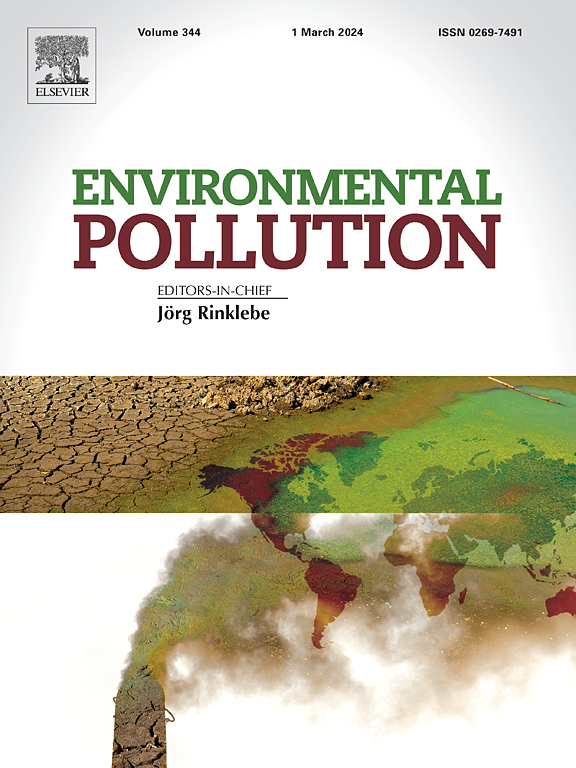Limited response of boreal forest litterfall mercury deposition to declines in atmospheric mercury concentrations (1987-2000)
IF 7.6
2区 环境科学与生态学
Q1 ENVIRONMENTAL SCIENCES
引用次数: 0
Abstract
Atmospheric mercury (Hg) uptake by vegetation and subsequent deposition via litterfall constitutes a major pathway in the global Hg cycle. However, the temporal dynamics of litterfall Hg deposition and its environmental controls remain poorly understood. Here, we present a detailed assessment of Hg concentrations and deposition fluxes for individual litter components in a Swedish boreal forest from 1987 to 2000. Atmospheric Hg concentrations declined 41% during this period. Correspondingly, Hg concentrations in Scots pine and Norway spruce needles decreased significantly (∼22% and ∼26%, respectively). However, the total litterfall Hg deposition flux remained stable at 11.7 ± 1.8 μg m-2 yr-1, showing no clear temporal trend. Foliar litter (needles) contributed 44% of total Hg deposition, while non-foliar litter (twigs, residual material, and cones) accounted for the remaining 56% (32%, 22%, and 2%, respectively). The importance of this non-foliar component in modulating litterfall Hg deposition is often overlooked. Litterfall Hg deposition was 1.7 times higher in the non-growing season than in the growing season, primarily due to greater litterfall biomass. The weak response of litterfall Hg deposition to declining atmospheric Hg concentrations highlights the importance of biological factors (e.g., litterfall compositions and productivity) in regulating Hg inputs to boreal forest. Our findings also underscore the need for long-term assessments of Hg deposition dynamics via different litterfall components for assessing the effectiveness of the Minamata Convention on Mercury.

北方森林凋落物汞沉降对大气汞浓度下降的有限响应(1987-2000)
植被对大气汞的吸收以及随后通过凋落物的沉积构成了全球汞循环的一个主要途径。然而,人们对凋落物汞沉积的时间动态及其环境控制仍知之甚少。在这里,我们详细评估了1987年至2000年瑞典北方森林中单个凋落物组分的汞浓度和沉积通量。在此期间,大气汞浓度下降了41%。相应地,苏格兰松和挪威云杉针叶中的汞浓度显著下降(分别为~ 22%和~ 26%)。而凋落物Hg总沉降通量稳定在11.7±1.8 μg m-2 -1,没有明显的时间变化趋势。叶面凋落物(针叶)占总汞沉积的44%,而非叶面凋落物(小枝、残材和球果)占剩余的56%(分别为32%、22%和2%)。这种非叶面成分在调节凋落物汞沉积中的重要性经常被忽视。非生长季凋落物Hg沉降量是生长季的1.7倍,主要是由于凋落物生物量较大。凋落物汞沉降对大气汞浓度下降的微弱响应突出了生物因子(如凋落物组成和生产力)在调节北方森林汞输入中的重要性。我们的研究结果还强调了通过不同凋落物组分对汞沉积动力学进行长期评估的必要性,以评估《关于汞的水俣公约》的有效性。
本文章由计算机程序翻译,如有差异,请以英文原文为准。
求助全文
约1分钟内获得全文
求助全文
来源期刊

Environmental Pollution
环境科学-环境科学
CiteScore
16.00
自引率
6.70%
发文量
2082
审稿时长
2.9 months
期刊介绍:
Environmental Pollution is an international peer-reviewed journal that publishes high-quality research papers and review articles covering all aspects of environmental pollution and its impacts on ecosystems and human health.
Subject areas include, but are not limited to:
• Sources and occurrences of pollutants that are clearly defined and measured in environmental compartments, food and food-related items, and human bodies;
• Interlinks between contaminant exposure and biological, ecological, and human health effects, including those of climate change;
• Contaminants of emerging concerns (including but not limited to antibiotic resistant microorganisms or genes, microplastics/nanoplastics, electronic wastes, light, and noise) and/or their biological, ecological, or human health effects;
• Laboratory and field studies on the remediation/mitigation of environmental pollution via new techniques and with clear links to biological, ecological, or human health effects;
• Modeling of pollution processes, patterns, or trends that is of clear environmental and/or human health interest;
• New techniques that measure and examine environmental occurrences, transport, behavior, and effects of pollutants within the environment or the laboratory, provided that they can be clearly used to address problems within regional or global environmental compartments.
 求助内容:
求助内容: 应助结果提醒方式:
应助结果提醒方式:


